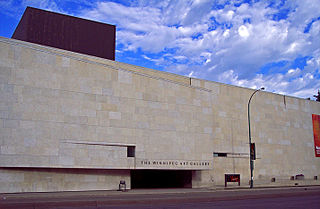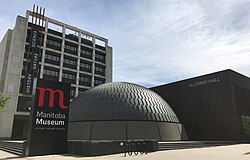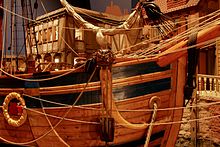
The Hudson's Bay Company is a Canadian retail business group. A fur trading business for much of its existence, it became the largest and oldest corporation in Canada, and now owns and operates retail stores across the country. The company's namesake business division is Hudson's Bay, commonly referred to as The Bay.

Manitoba is a province of Canada at the longitudinal centre of the country. It is Canada's fifth-most populous province, with a population of 1,342,153 as of 2021. Manitoba has a widely varied landscape, from arctic tundra and the Hudson Bay coastline in the north to dense boreal forest, large freshwater lakes, and prairie grassland in the central and southern regions.

Hudson Bay, sometimes called Hudson's Bay, is a large body of saltwater in northeastern Canada with a surface area of 1,230,000 km2 (470,000 sq mi). It is located north of Ontario, west of Quebec, northeast of Manitoba and southeast of Nunavut, but politically entirely part of Nunavut. It is an inland marginal sea of the Arctic Ocean. The Hudson Strait provides a connection between the Labrador Sea and the Atlantic Ocean in the northeast, while the Foxe Channel connects the Hudson Bay with the Arctic Ocean in the north. It drains a very large area, about 3,861,400 km2 (1,490,900 sq mi), that includes parts of southeastern Nunavut, Alberta, Saskatchewan, Ontario, Quebec, all of Manitoba, and parts of the U.S. states of North Dakota, South Dakota, Minnesota, and Montana. Hudson Bay's southern arm is called James Bay.

Hudson's Bay, also known as The Bay, is a Canadian department store chain. It is the flagship brand of the Hudson's Bay Company (HBC), the oldest and longest-surviving company in North America as well as one of the oldest and largest continuously operating companies in the world.

Canada has a large domestic and foreign tourism industry. The second largest country in the world, Canada's wide geographical variety is a significant tourist attractor. Much of the country's tourism is centred in the following regions: Toronto, Montreal, Quebec City, Vancouver/Whistler, Niagara Falls, Vancouver Island, Canadian Rockies, British Columbia's Okanagan Valley, Churchill, Manitoba and the National Capital Region of Ottawa-Gatineau. The large cities are known for their culture, diversity, as well as the many national parks and historic sites.

The University of Winnipeg is a public research university in Winnipeg, Manitoba, Canada. It offers undergraduate programs in art, business, economics, education, science and applied health as well as graduate programs. UWinnipeg's founding colleges were Manitoba College and Wesley College, which merged to form United College in 1938. The University of Winnipeg was established in 1967 when United College received its charter.

The Winnipeg Art Gallery (WAG) is an art museum in Winnipeg, Manitoba, Canada. Its permanent collection includes over 24,000 works from Canadian, Indigenous Canadian, and international artists. The museum also holds the world's largest collection of Inuit art. In addition to exhibits for its collection, the museum has organized and hosted a number of travelling arts exhibitions. Its building complex consists of a main building that includes 11,000 square metres (120,000 sq ft) of indoor space and the adjacent 3,700-square-metre (40,000 sq ft) Qaumajuq building.

Nonsuch was the ketch that sailed into Hudson Bay in 1668-1669 under Zachariah Gillam, in the first trading voyage for what was to become the Hudson's Bay Company two years later. Originally built as a merchant ship in 1650, and later the Royal Navy ketch HMS Nonsuch, the vessel was sold to Sir William Warren in 1667. The name means "none such", i.e. "unequalled". The ship was at the time considered smaller than many others but was specifically selected because of her small size so that when she arrived in Hudson Bay and James Bay she could be sailed up-river and taken out of water so the thick ice of the bay wouldn't crush her.
Manitoba Centennial Centre is an arts and cultural district that covers a 34-acre area in the east Exchange District of the Point Douglas area in Winnipeg, Manitoba, linking several of Manitoba's important arts and cultural facilities. It includes the Centennial Concert Hall, the Manitoba Museum, Planetarium and Science Gallery, the Royal Manitoba Theatre Centre, Manitoba Production Centre, Artspace, three nearby surface parking lots, and the building at 11 Lily Street. Founded as an urban renewal program in 1960, the Centre now sees 930,000 patrons annually at its venues. The Manitoba Centennial Centre Corporation (MBCCC)—a Manitoba Crown corporation established in 2005—manages the centre.

The Winnipeg Railway Museum was a railway museum located on tracks 1 and 2 within the Via Rail-operated Union Station in Winnipeg, Manitoba, Canada. Volunteers from the Midwestern Rail Association Inc., a non-profit organization founded in 1975, operated the museum.

Manitoban culture is a term that encompasses the artistic elements that are representative of Manitoba. Manitoba's culture has been influenced by both traditional and modern Canadian artistic values, as well as some aspects of the cultures of immigrant populations and its American neighbours. In Manitoba, the Minister of Culture, Heritage, Tourism and Sport is the cabinet minister responsible for promoting and, to some extent, financing Manitoba culture. The Manitoba Arts Council is the agency that has been established to provide the processes for arts funding. The Canadian federal government also plays a role by instituting programs and laws regarding culture nationwide. Most of Manitoba's cultural activities take place in its capital and largest city, Winnipeg.

Archives of Manitoba, formerly the Provincial Archives of Manitoba until 2003, is the official government archive of the Canadian province of Manitoba. It is located at 200 Vaughan Street in Winnipeg, where it has been established since January 1971.

Settlers, Rails & Trails Inc. is a community-run, non-profit museum in Argyle, Manitoba. It exhibits local history, railway and agricultural artifacts and historical information, and it is also home to the Canadian Flag Collection. Argyle is governed by the Rural Municipality of Rockwood, and is located approximately 28 km northwest of Winnipeg, within the Manitoba Capital Region.
Sherry Farrell Racette is a Métis-Canadian feminist scholar, author, curator, and artist. She is best known for her contributions to Indigenous and Canadian art histories. She is currently an associate professor of Visual Arts at the University of Regina.
Leesa Streifler is a Canadian multi-disciplinary artist and art professor who lives in Winnipeg, Manitoba. Her works have been exhibited extensively in solo and group exhibitions, nationally and internationally, and appear in the permanent collection of the National Gallery of Canada and the Canadian Museum of Contemporary Photography.
Clara Hume was a Canadian painter. Her work is largely focused on landscapes and still lifes. Her paintings have been exhibited in Saskatchewan and Manitoba as part of group and solo exhibitions. She was particularly noted for her detailed acrylic paintings of prairie wildflowers and grasses, and prairie landscapes.
Darlene Coward Wight is a Canadian art historian who has been Curator of Inuit art at the Winnipeg Art Gallery (WAG) since 1986.
William H. Lobchuk, known as Bill Lobchuk was one of the first people in Canada to found a printshop which made printmaking facilities available to contemporary artists. In 1968 he opened the Screen Shop at 50 Princess Street in Winnipeg with partner Len Anthony, which led to the founding of The Grand Western Canadian Screen Shop in 1973. It was the first print shop of its kind in Western Canada and a focus of printmaking production and distribution for artists, both in the Prairies and Canada-wide.
George Swinton L.L. D. was a Canadian painter, historian, and one of the earliest writers and collectors of Inuit art. His book Eskimo Sculpture was published in 1965. A second book Sculpture of the Eskimo followed in 1972, a third Sculpture of the Inuit in 1999.


















